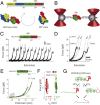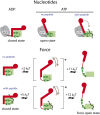Nanomechanics of the substrate binding domain of Hsp70 determine its allosteric ATP-induced conformational change
- PMID: 28533394
- PMCID: PMC5468673
- DOI: 10.1073/pnas.1619843114
Nanomechanics of the substrate binding domain of Hsp70 determine its allosteric ATP-induced conformational change
Abstract
Owing to the cooperativity of protein structures, it is often almost impossible to identify independent subunits, flexible regions, or hinges simply by visual inspection of static snapshots. Here, we use single-molecule force experiments and simulations to apply tension across the substrate binding domain (SBD) of heat shock protein 70 (Hsp70) to pinpoint mechanical units and flexible hinges. The SBD consists of two nanomechanical units matching 3D structural parts, called the α- and β-subdomain. We identified a flexible region within the rigid β-subdomain that gives way under load, thus opening up the α/β interface. In exactly this region, structural changes occur in the ATP-induced opening of Hsp70 to allow substrate exchange. Our results show that the SBD's ability to undergo large conformational changes is already encoded by passive mechanics of the individual elements.
Keywords: elasticity; force; laser trapping; parallel pathways; protein extension.
Conflict of interest statement
The authors declare no conflict of interest.
Figures





References
-
- Müller DJ, Dufrêne YF. Atomic force microscopy as a multifunctional molecular toolbox in nanobiotechnology. Nat Nanotechnol. 2008;3:261–269. - PubMed
-
- Calloni G, et al. DnaK functions as a central hub in the E. coli chaperone network. Cell Reports. 2012;1:251–264. - PubMed
-
- Mayer MP. Hsp70 chaperone dynamics and molecular mechanism. Trends Biochem Sci. 2013;38:507–514. - PubMed
Publication types
MeSH terms
Substances
LinkOut - more resources
Full Text Sources
Other Literature Sources
Molecular Biology Databases

